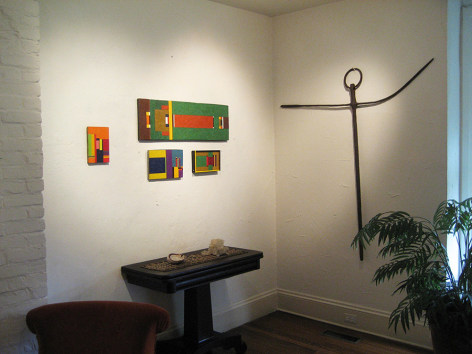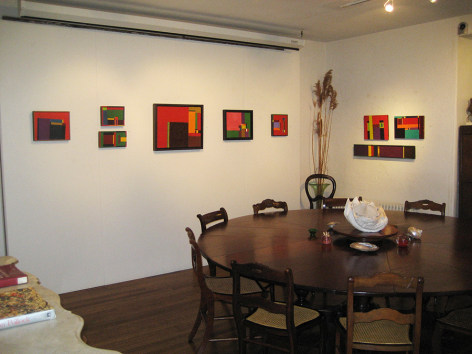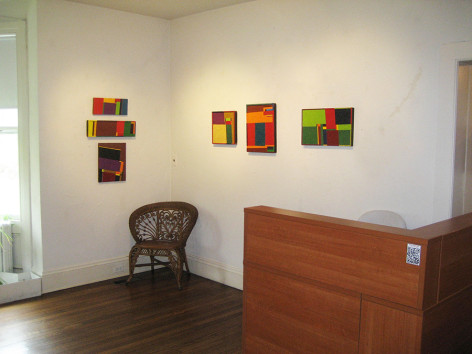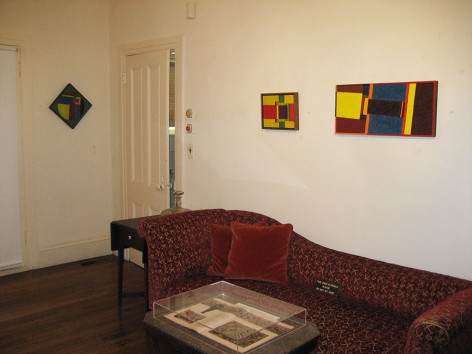Roy Newell A Recollection
Roy Newell was 81 when I met him in 1995, and I was 27. He invited me into his studio from time to time to see his paintings. After a while, I began to come by regularly. I would help him move things around, but most of the time he just wanted to talk and look at the paintings. In the eleven years I knew him, he never started a new painting. He repainted his small works endlessly. One month I would come by to see a room full of electric blues and violets, only to return a month later to the same works in ruddy browns and oranges. Frustrated, I constructed a stack of freshly primed new panels in sizes that he specified. They remained unused forever. Over many years, I came back often (and enough) to see the paintings evolve, and to begin to understand their importance both to him and to painting in general. He was endlessly fine tuning, and they were developing incrementally, almost imperceptibly, like mineral deposits, into distillations of his intentions.
He worked in his apartment, usually sitting on a small chair and resting the painting in his lap or sometimes placing it in front of him on another small wooden chair. The space resembled something between a tackle shop, a bodega, and a Parisian salon. The walls were completely covered by his small, gem-like abstractions, which had been arranged intuitively over many years into a rhythmic choreography. He used the old (high pigment count) Windsor and Newton oil paint, and squeezed it out of the small tubes directly onto his brush. He usually applied the color without mixing. He had a substantial supply of the paint stacked up in huge piles of boxes throughout his apartment. He painted every day, and was supported and cared for by his wife, Anne, who is one of the most extraordinary people I have ever met. She enabled his passions, and never wavered in her irreverent wit and good humor despite decades of what she referred to as “Roy’s black cloud.”
Roy could be extremely charming, but also very disagreeable. A child of the Depression, he was both highly sensitive and very raw. To me, Roy was a window into a time long gone by. His memories were vivid colorations of the key characters—Bill and Elaine de Kooning, Franz Kline, Jackson Pollock, Philip Guston, and others. We would sit on a park bench or in a Chinese restaurant in Chelsea, and he would recount evenings at the Cedar Tavern. It was an education. His best friends were de Kooning and Kline. It would seem nothing had changed, in many ways, between then and now. “Only make friends, no enemies,” de Kooning would often say to Roy. Roy paid no attention.
In the 1950s, Roy had a few very successful years. When things started to cool down he started drinking more. For him and many of his fellow artists, the drinking was on a level well beyond “heavy.” When they had money, they bought paint, and cigarettes, and booze. One day, they were all sitting at the nickel-bowl-of-soup cafeteria where they ate lunch, and Franz Kline drove up in a new Ferrari that he had just traded to a collector for paintings.* In the context of their formative years during the Great Depression, it symbolized a level of success that was almost unimaginable, and that Roy would never achieve. What made matters worse was that when the other painters were pioneering the “big painting,” Roy shifted his scale dramatically. He consciously abandoned the grand gesture and the epic canvas in favor of a hermetic and subtle approach. He emulated Albert Pinkham Ryder, Puvis de Chavannes , Vuillard, Bonnard, and Cézanne. Sometime in the mid 1960s he destroyed many of his early paintings. His work went quietly out of fashion.
The next two decades saw very little activity. Roy began to withdraw from his friends. Elaine and Bill de Kooning continued to champion his work, but few others paid attention. He slid into an alcoholic stupor from which he was eventually able to pull himself twenty years later. During all this time of isolation, Roy was still painting. For Roy, art became a private mythology. His daily practice was the nourishment against the famine of oblivion. He worked on the same group of some 50 paintings for five decades. To my knowledge, these finished works represent one of the most extreme examples of sustained attention in the history of post-war painting. Each small painting has thousands of hours embedded in it. They are compressions of both time and emotion. A lifetime of shifting daily moods and inspirations both buried and revealed in color and touch.
Despite Roy’s very limited exhibition history, whenever he did show, he received great critical response. This was enormously vindicating for him. In a 1986 half page New York Times review of Roy’s solo show at Dowling College, Helen A. Harrison wrote:
The long-term, single minded pursuit of a narrow, self- imposed esthetic discipline is rare among visual artists, most of whom undergo the periodic changes in style or viewpoint that we associate with a developing career. Those uncommon few who commit themselves to an approach at once so clearly defined and so personal that it seems to exist outside of time exert a special fascination, especially on the imaginations of their fellow artists. As Morandi represents the ideal “painter’s painter” for the gestural realists, so we might think of Roy Newell as a paragon for the geometric abstractionists.”
Roy’s next show ten years later was a comprehensive retrospective at John Woodward’s Gallery of Living Artists in New York City. Two years after that, Roy showed again in New York at Earl McGrath Gallery. This show was also reviewed in The Times. Holland Cotter wrote,”Mr. Newell’s palette is bright but complicated and holds some audacious surprises: passages of brown and flesh-pink, for instance, carry anatomical associations of a kind found in the work of certain younger abstract painters today.”
Lastly, of Roy’s highly successful 2010 posthumous show at Carolina Nitsch Project Room in Chelsea, Roberta Smith wrote in The Times, “This exhibition will introduce many people to the vehement, transcendent geometry of Roy Newell, an all but unknown painter who died in 2006 at 92. It also expands the perimeters of the New York School with a solid, sudden jolt.”
A jolt indeed—this show at the Pollock-Krasner House will once again give the public a chance to see these extraordinary works. It will also put Roy’s paintings in the historical context they so richly deserve, and shed light on an alternative history of the New York School.
Richard Dupont
January 2014




